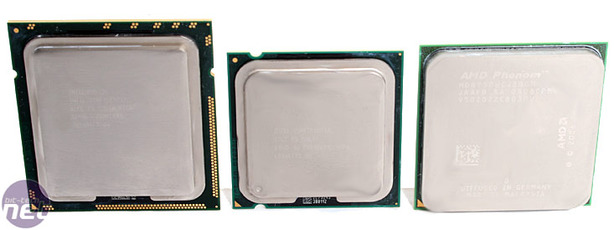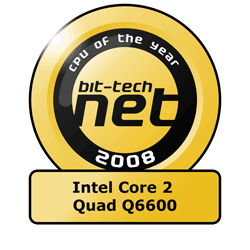
The 2008 bit-tech Hardware Awards
This year has been an interesting year for PC gaming and if you’ve been reading the site over the past few days, you will have already seen that we’ve published the top ten PC games of the year, as voted for by our readers. But regular bit-tech readers know that bit-tech is about more than just games.It’s been a very busy time for PC Enthusiasts - and for us especially - with masses upon masses of enthusiast-orientated products released which all claim to be the best thing since sliced bread. It's been a big year for overclockers in particular, with 2008 seeing a big push by Taiwanese manufacturers to competitions for overclocking and performance - although advances and achievements from these events have not necessarily developed the best products in our opinion, because "enthusiast" means more than that.
At bit-tech, just about every enthusiast-orientated product that matters comes through our hands, whether that's for a brief time or a full review. With the Christmas festivities now over, it’s about time we looked back at the many products that have come across our desks last year in order to come up with our top hardware products of 2008.
Despite the industry moving at breakneck speeds sometimes, some of the products we’ve chosen for this article were released very early last year... or maybe even in 2007 in some cases, but they’ve still made a massive impression on the market over the course of 2008 - that is a testament of a good product.
Over the course of this article, we’ll cover everything from cases, chipsets, cooling, CPUs, graphics, memory, motherboards and much more. So read on for our pick from the year’s slew of enthusiast kit...
Best CPU: Intel Core 2 Quad Q6600
Notable Mentions: Intel Core i7 920, Intel Core 2 Duo E8400, AMD Athlon 64 X2 4850eOne thing's for sure, we didn't expect to still see the Core 2 Quad Q6600 ruling the roost again in 2008, but it has continued to cause a number of problems for AMD's quad-core processor line up. It's not only a great performer out of the box, but it's also a great overclocker with nearly every Q6600 hitting at least 3.0GHz - and most going well beyond this with rudimentary air cooling.
At those clock speeds, AMD was simply unable to compete with the Q6600's bang for buck because its Phenom processors just didn't scale to the same kinds of clock speeds that Intel's cheapest quad-core could achieve. Because of this, AMD has been playing catch up all year and even though the company launched its 'fixed' B3-stepping Phenom X4 processors in April, there still wasn't enough of a reason to move from Blue to Green if you were considering quad-core.

Although our processor of the year hasn't changed, there have been a lot of changes in the CPU market over the course of the year. The first major change was the introduction of AMD's triple-core Phenom processors. Based on the fixed Agena B3 silicon with one core disabled, the Phenom X3 processors were aimed squarely at Intel's mid-range dual-core CPUs but didn't really succeed.
While our Phenom X3 8750 overclocked rather well, the performance advantage over a Core 2 Duo E8400 (our favoured dual-core processor of the year) wasn't there for the most part and the real sucker punch was the Core 2 Quad Q6600, which not only bested the X3 in heavily multi-threaded scenarios, but also in those applications that are more reliant on single threaded performance and clock speed. And, what's more, it wasn't much more expensive and led to AMD making further price cuts.
AMD's triple-core Phenom introduction wasn't the biggest change that took place though - there were two more major shifts in the market that both happened to come from Intel. The introduction of the Atom processor in June was a major move at the bottom end of the market and started the era of 'good enough' computing - we'll be talking about that a bit more later.

The final shift was left for the much-discussed Nehalem architecture behind Intel's Core i7 CPUs. Introduced in November, the Core i7 packed four processing cores - each with two execution threads via HyperThreading and 256KB of L2 cache - and a huge L3 cache onto a single die. Nehalem also integrated the memory controller onto the CPU - something that Intel had moved away from previously, and something AMD has done since 2003 when it launched the original Opteron processor - bringing an end to the front side bus.
There were concerns about overclocking before launch, but those were nullified as soon as we got our hands on the CPUs. The Core i7's main problem was its high barrier for entry, which made the Core i7 model 920 processor the ideal starting point at its sub-£250 asking price. What cemented this fact was how well and with how little effort the Core i7 overclocks - we've had all of our Core i7 chips running at over 3.7GHz stably with very little tweaking. That includes the two chips in our new Core i7-based graphics test systems.
It wasn't all doom and gloom for AMD this year though and although Intel's processors won us over in the higher-end segments, AMD remained incredibly strong at the lower end of the spectrum with processors that were ideally suited to Home Theatre PCs and Media Centres.
The company introduced the Phenom X4 9350e - a 65W quad-core designed with this market in mind - but we felt that it had limited appeal because the number of codecs with enough threading to make four cores viable are limited. The extremely low power 45W Athlon X2 4850e turned out to be a better solution for home theatre enthusiasts and it has been in our buyers guide since our first one in October.

MSI MPG Velox 100R Chassis Review
October 14 2021 | 15:04








Want to comment? Please log in.